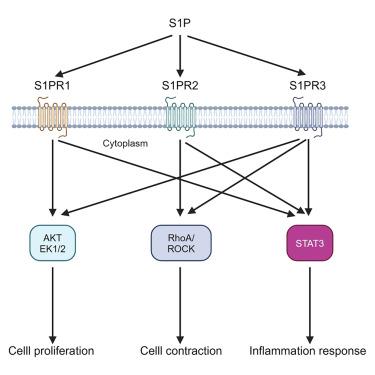Broad and diverse roles of sphingosine-1-phosphate/sphingosine-1-phosphate receptors in the prostate
IF 4.6
2区 综合性期刊
Q1 MULTIDISCIPLINARY SCIENCES
引用次数: 0
Abstract
Benign prostatic hyperplasia (BPH) is a common condition in aging males, but its underlying pathogenesis remains unclear. Sphingosine-1-phosphate (S1P) and its receptors (S1PRs) play important roles in various diseases, while less studied in prostate. Current study attempts to clarify the expression and functional activities of S1P/S1PRs in the prostate. We discovered that S1P/S1PRs were richly expressed in the prostate, with S1PR1/2/3 localized in the epithelial/stromal compartments, while S1PR4/5 were less expressed. In vitro, S1P/S1PR1/S1PR3 promoted cell proliferation via AKT and ERK1/2 pathways, S1P/S1PR2/S1PR3 enhanced contraction of WPMY-1 cells and human prostate via RhoA/ROCK pathway, while S1P/S1PR1/S1PR2/S1PR3 alleviated the inflammation response via STAT3 pathway. In vivo, S1P and S1PR1/3 agonists (SEW2871, CYM5541) led to prostate enlargement in rats, while S1PR1/3 antagonists (W-146, TY-52156) suppressed testosterone-induced BPH. Overall, this study suggests that S1P/S1PRs play a critical role in the development of BPH and may be a promising therapeutic target for BPH treatment.

鞘氨醇-1-磷酸/鞘氨醇-1-磷酸受体在前列腺中的广泛而多样的作用
良性前列腺增生症(BPH)是老年男性的常见病,但其潜在的发病机制仍不清楚。两性鞘氨醇-1-磷酸(S1P)及其受体(S1PRs)在多种疾病中发挥着重要作用,但对前列腺的研究较少。本研究试图阐明 S1P/S1PRs 在前列腺中的表达和功能活动。我们发现 S1P/S1PRs 在前列腺中表达丰富,其中 S1PR1/2/3 定位于上皮/基质区,而 S1PR4/5 则表达较少。在体外,S1P/S1PR1/S1PR3 通过 AKT 和 ERK1/2 途径促进细胞增殖,S1P/S1PR2/S1PR3 通过 RhoA/ROCK 途径增强 WPMY-1 细胞和人类前列腺的收缩,而 S1P/S1PR1/S1PR2/S1PR3 则通过 STAT3 途径减轻炎症反应。在体内,S1P 和 S1PR1/3 激动剂(SEW2871、CYM5541)会导致大鼠前列腺增生,而 S1PR1/3 拮抗剂(W-146、TY-52156)会抑制睾酮诱导的良性前列腺增生。总之,这项研究表明,S1P/S1PRs 在良性前列腺增生症的发病过程中起着关键作用,可能是治疗良性前列腺增生症的一个有前途的治疗靶点。
本文章由计算机程序翻译,如有差异,请以英文原文为准。
求助全文
约1分钟内获得全文
求助全文
来源期刊

iScience
Multidisciplinary-Multidisciplinary
CiteScore
7.20
自引率
1.70%
发文量
1972
审稿时长
6 weeks
期刊介绍:
Science has many big remaining questions. To address them, we will need to work collaboratively and across disciplines. The goal of iScience is to help fuel that type of interdisciplinary thinking. iScience is a new open-access journal from Cell Press that provides a platform for original research in the life, physical, and earth sciences. The primary criterion for publication in iScience is a significant contribution to a relevant field combined with robust results and underlying methodology. The advances appearing in iScience include both fundamental and applied investigations across this interdisciplinary range of topic areas. To support transparency in scientific investigation, we are happy to consider replication studies and papers that describe negative results.
We know you want your work to be published quickly and to be widely visible within your community and beyond. With the strong international reputation of Cell Press behind it, publication in iScience will help your work garner the attention and recognition it merits. Like all Cell Press journals, iScience prioritizes rapid publication. Our editorial team pays special attention to high-quality author service and to efficient, clear-cut decisions based on the information available within the manuscript. iScience taps into the expertise across Cell Press journals and selected partners to inform our editorial decisions and help publish your science in a timely and seamless way.
 求助内容:
求助内容: 应助结果提醒方式:
应助结果提醒方式:


